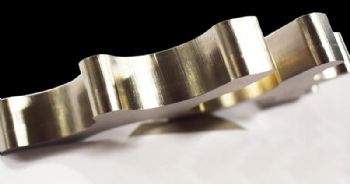
In order to push the quality of fibre laser cutting to new levels, Kidderminster-based Amada (
www.amada.co.uk) is releasing two new technologies — Silky Cut Fibre and Gas Mixer.
Available for the company’s ENSIS and LCG (4kW+) ranges of fibre laser cutting machines, these developments have been designed to ensure superior quality (in compa-rison with standard fibre lasers).
Amada says that while the industry’s on-going demand for fibre laser technology has been driven by high process speeds, it is well documented that quality dips below that of CO
2 lasers when working on thicker sheets of certain materials.
With this in mind, the company’s Silky Cut Fibre has been developed to offer CO
2-quality stainless steel processing up to 15mm thick using fibre laser technology.
It is a combination of Amada’s own fibre laser source, a new cutting-head design and optimisation of the beam-path optics, as well as the company’s advanced understanding of gas-flow dynamics and beam-shaping techniques.
Amada says: “Customers can now process mid-to-thick stainless steel with the confidence that it will meet the highest standards.
“In addition, users processing thicker materials can now enjoy the reduction in energy consumption associated with fibre laser cutting — typically 70%.”
Meanwhile, Gas Mixer is designed to provide the CO2-quality processing of aluminium using fibre laser technology. Amada says that while near dross-free aluminium fibre laser profiling can be achieved using oxygen as the cutting gas, the inability to weld after oxygen cutting means that this solution is rarely used.
As a result, most users opt for nitrogen when cutting aluminium, which is fast but results in a level of quality that is less than satisfactory in some instances.
With Amada’s Gas Mixer system, gases are mixed in a ratio that ensures the optimum combination of improved cut quality and post-cutting weldability.
Amada says. “Subsequently, users have the potential to eliminate secondary operations and reduce welding defects when compared with oxygen-cut parts.
“Manufacturers working in the automotive, aerospace and general sub-contract markets will be among those to benefit most.”
Along with Silky Cut Fibre and Gas Mixer, customers choosing ENSIS machines have the benefit of variable beam control technology; this allows the high-speed processing of thin materials, the high-quality processing of thick mild steel (with negligible taper), and the high-speed piercing of thick mild steel.
Moreover, the 3kW ENSIS fibre laser can process the same thickness of mild steel (25mm) as a standard 6kW fibre laser, but with half the power.
Amada says that the result is lower cost-per-part, lower energy bills and greater profit margins, adding that ENSIS machines have proved particularly popular among sub-contractors wanting flexibility with reduced process costs.
In conclusion, Amada says that while many manufacturers are switching to fibre laser technology to increase profit through faster processing and reduced energy consumption on thin parts, quality can be compromised at the thicker end of the material spectrum.
“With this in mind, any fabrication or profiling shop faced with processing both thin and thick materials can opt for Silky Cut Fibre and Gas Mixer to enjoy benefits across the board.
“There will no longer be any need to retain a CO
2 laser cutting machine — or to compromise on quality.”